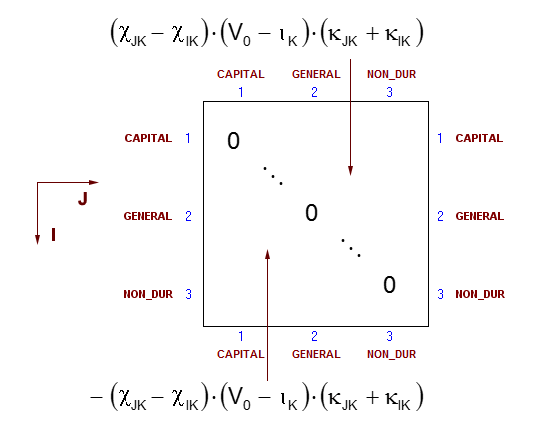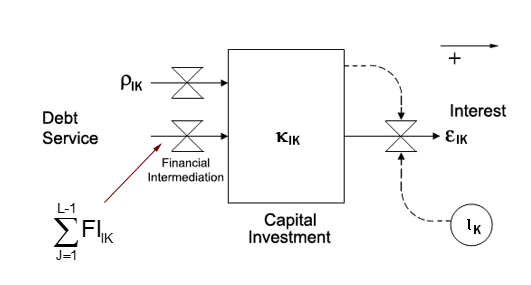The Calculation of an economy K’s interest rate -nK and its investment term TK has, to this point, been attributed to a financial intermediary that is only manifest in terms of his contra-accounts to investment k0K and savings g0K. Model 0 portrays the intermediary as ‘transparent’ in that he performs his tasks without remuneration or any motive other than efficiency. Preparation for more realistic models requires that Model 0’s ideal intermediary be completed with one more function, viz.: he must move funds among the industrial sectors’ capital positions kIK so as to guide the sectors toward the unifying end-state defined by cIK=1.
An industrial sector having a greater marginal value of money cIK than another is the better investment. It follows, therefore, that a process of financial intermediation adjusting capital positions kIK in search of maximal returns should operate to equalize the cIK’s among the sectors — which can only happen when all the sectors’ marginal values of money align with money’s spot price of unity.
Model 0’s stated objective being to establish the simplest operative representation capitalism’s dynamics suggests the following matrix formulation of the data needed for successful financial intermediation.

If money is to be usefully transferred between two industrial sectors IK and JK, the rate of transfer would logically be proportional to the sum of these sector’s capital positions kJK+k IK. This quantity would be propelled by the quantity V0-iK, which transforms a capital position into a sector’s rate of expenditure for asset replenishment, plus its expected profit. The third factor going into each element of this matrix would be the difference between the sectors’ marginal values of money cJK-cIK.
Diagonal elements in the intermediation matrix are of course null because flows from a capital position to itself would be meaningless. In an instance where a cell in the upper triangle of this matrix expresses a flow into a sector IK from a sector JK, that cell’s reciprocal in the lower triangle receives its negated value in order to express the flow out of JK. Thus the sum of all flows in the intermediation matrix are always null. While the intermediary does create and annihilate capital by offsetting entries to his contra-account, every credit must be offset by a debit. There can be no ‘one-sided’ journal entries: an intermediary is not allowed to move money from nowhere to somewhere.
A sum across the entries for a given row IK of the ‘FI matrix’ above computes the net of all the intermediary’s additions and subtractions for a given capital position kIK. These sums can now be used to complete our earlier depiction of the elements by which an industrial sector’s capital position is controlled:
